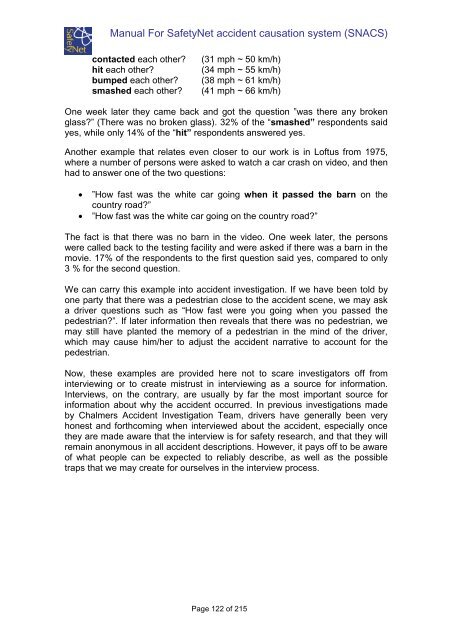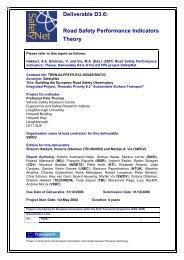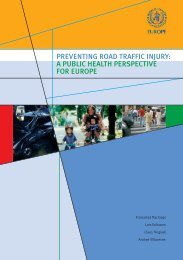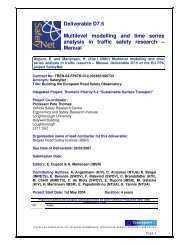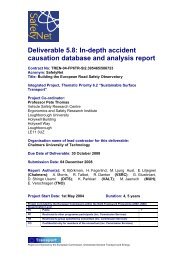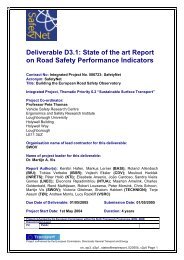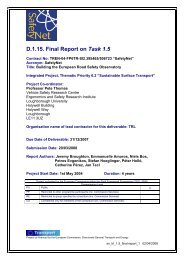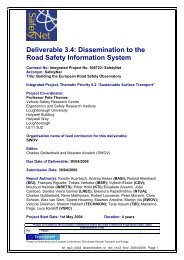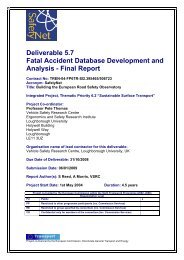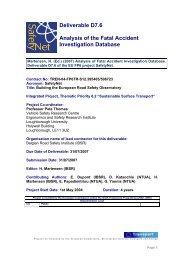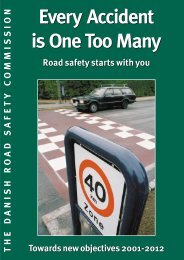Glossary of Data Variables for Fatal and accident causation ... - ERSO
Glossary of Data Variables for Fatal and accident causation ... - ERSO
Glossary of Data Variables for Fatal and accident causation ... - ERSO
You also want an ePaper? Increase the reach of your titles
YUMPU automatically turns print PDFs into web optimized ePapers that Google loves.
Manual For SafetyNet <strong>accident</strong> <strong>causation</strong> system (SNACS)<br />
contacted each other<br />
hit each other<br />
bumped each other<br />
smashed each other<br />
(31 mph ~ 50 km/h)<br />
(34 mph ~ 55 km/h)<br />
(38 mph ~ 61 km/h)<br />
(41 mph ~ 66 km/h)<br />
One week later they came back <strong>and</strong> got the question ”was there any broken<br />
glass” (There was no broken glass). 32% <strong>of</strong> the “smashed” respondents said<br />
yes, while only 14% <strong>of</strong> the “hit” respondents answered yes.<br />
Another example that relates even closer to our work is in L<strong>of</strong>tus from 1975,<br />
where a number <strong>of</strong> persons were asked to watch a car crash on video, <strong>and</strong> then<br />
had to answer one <strong>of</strong> the two questions:<br />
• ”How fast was the white car going when it passed the barn on the<br />
country road”<br />
• ”How fast was the white car going on the country road”<br />
The fact is that there was no barn in the video. One week later, the persons<br />
were called back to the testing facility <strong>and</strong> were asked if there was a barn in the<br />
movie. 17% <strong>of</strong> the respondents to the first question said yes, compared to only<br />
3 % <strong>for</strong> the second question.<br />
We can carry this example into <strong>accident</strong> investigation. If we have been told by<br />
one party that there was a pedestrian close to the <strong>accident</strong> scene, we may ask<br />
a driver questions such as “How fast were you going when you passed the<br />
pedestrian”. If later in<strong>for</strong>mation then reveals that there was no pedestrian, we<br />
may still have planted the memory <strong>of</strong> a pedestrian in the mind <strong>of</strong> the driver,<br />
which may cause him/her to adjust the <strong>accident</strong> narrative to account <strong>for</strong> the<br />
pedestrian.<br />
Now, these examples are provided here not to scare investigators <strong>of</strong>f from<br />
interviewing or to create mistrust in interviewing as a source <strong>for</strong> in<strong>for</strong>mation.<br />
Interviews, on the contrary, are usually by far the most important source <strong>for</strong><br />
in<strong>for</strong>mation about why the <strong>accident</strong> occurred. In previous investigations made<br />
by Chalmers Accident Investigation Team, drivers have generally been very<br />
honest <strong>and</strong> <strong>for</strong>thcoming when interviewed about the <strong>accident</strong>, especially once<br />
they are made aware that the interview is <strong>for</strong> safety research, <strong>and</strong> that they will<br />
remain anonymous in all <strong>accident</strong> descriptions. However, it pays <strong>of</strong>f to be aware<br />
<strong>of</strong> what people can be expected to reliably describe, as well as the possible<br />
traps that we may create <strong>for</strong> ourselves in the interview process.<br />
Page 122 <strong>of</strong> 215


